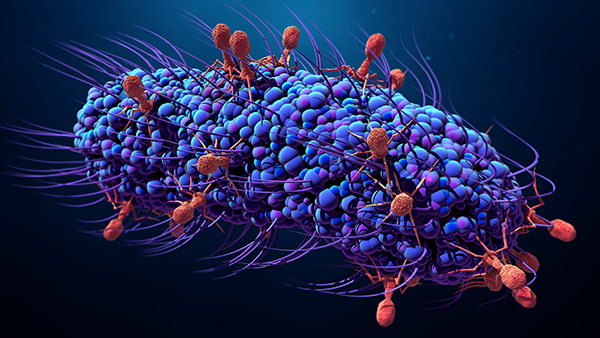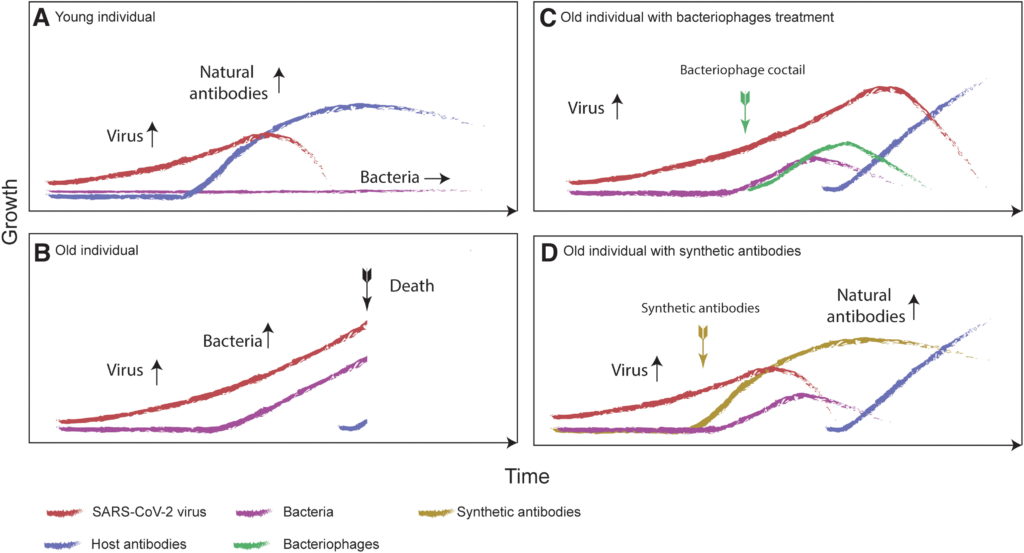DISCOVERED BY RUSSIANS AND DEVELOPED BY SOVIET SCIENCE AS AN ALTERNATIVE THERAPY TO ANTIBIOTICS, IGNORED BY THE WEST FOR SEVENTY YEARS UNTIL THE ADVENT OF SUPERBUGS

It’s possible that I shall make an ass of myself. But in that case one can always get out of it with a little dialectic. I have, of course, so worded my proposition as to be right either way (K.Marx, Letter to F.Engels on the Indian Mutiny)


 Figure 1. Theoretical time courses of the SARS-CoV-2 virus growth (red curves), bacterial growth (purple curves), and host antibody production (blue curves) for four scenarios. (A) A young healthy individual who has no problems developing antibodies to the virus infection. (B) An old individual who experiences delayed antibody production, resulting in bacterial growth as well as increased virus growth. (C) An old individual for whom a bacteriophage cocktail against bacterial growth was introduced as a part of standard therapy. Increase of bacteriophages is marked (green curve) with the time of treatment (green arrow). The relationship between bacteriophages and bacteria can be described by the Lotkka-Voltera population model. The viral load does not decrease until the body’s natural antiviral antibodies are produced but more time is bought for this to happen. (D) An old individual for whom synthetic antibodies were introduced (brown curve), creating an immediate reduction in the viral load and once again buying time for the natural antibodies to be produced. SARS-CoV-2, severe acute respiratory syndrome coronavirus 2.
Figure 1. Theoretical time courses of the SARS-CoV-2 virus growth (red curves), bacterial growth (purple curves), and host antibody production (blue curves) for four scenarios. (A) A young healthy individual who has no problems developing antibodies to the virus infection. (B) An old individual who experiences delayed antibody production, resulting in bacterial growth as well as increased virus growth. (C) An old individual for whom a bacteriophage cocktail against bacterial growth was introduced as a part of standard therapy. Increase of bacteriophages is marked (green curve) with the time of treatment (green arrow). The relationship between bacteriophages and bacteria can be described by the Lotkka-Voltera population model. The viral load does not decrease until the body’s natural antiviral antibodies are produced but more time is bought for this to happen. (D) An old individual for whom synthetic antibodies were introduced (brown curve), creating an immediate reduction in the viral load and once again buying time for the natural antibodies to be produced. SARS-CoV-2, severe acute respiratory syndrome coronavirus 2.
Phables computational tool 'beats existing viral identification methods'
FLINDERS UNIVERSITY
IMAGE:
DR VIJINI MALLAWAARACHCHI, RESEARCH ASSOCIATE IN BIOINFORMATICS, FLINDERS ACCELERATOR FOR MICROBIOME EXPLORATION (FAME) LAB, COLLEGE OF SCIENCE AND ENGINEERING, FLINDERS UNIVERSITY
view moreCREDIT: FLINDERS UNIVERSITY
A new bioinformatics software program at Flinders University is paving the way for a rapid expansion of research into bacteriophages, the viruses or phages that play key roles in controlling bacteria.
Experts at the Flinders University College of Science and Engineering have released a computational tool for researchers around the world to find ‘bacteriophages’ or phages through more accurate genome sequencing.
The new ‘Phables’ computational tool can identify and characterise 49% more complete phage genomes compared to existing viral identification tools, according to a new article in Bioinformatics.
Research into isolating and harnessing bacteriophages paves the way for progress in the emerging field of ‘phage therapy’, a more natural way to target specific bacteria which post a constant risk to immune-compromised, young and elderly patients, as well as ‘super’ bacteria which has become resistant to regular antibiotics.
Antimicrobial resistance (AMR) is a major global risk when broad-spectrum antibiotics no longer work on ‘superbugs’ created when common bacteria goes through multiple genetic changes. The WHO has warned that AMR is one of the top public health threats facing humanity in the 21st century and was associated with the death of close to 5 million people in 2019.
“Understanding phages is essential because they can influence everything from the health of ecosystems to the treatment of bacterial infections in humans,” says Flinders University research associate Dr Vijini Mallawaarachchi, from the Flinders Accelerator for Microbiome Exploration (FAME) Lab.
“Traditional methods of studying phages from environmental sequencing data have been limited, often failing to fully capture the complete genetic information of phages. This incomplete picture has been a barrier to fully understanding their roles and impacts.”
FAME Lab director Professor Robert Edwards, a coauthor of the latest article, says the Phables software can computationally reconstruct the genetic content of phages from environmental sequencing data.
“This marks a major advancement in phage bioinformatics, allowing us to computationally reconstruct complete phage genomes,” says Professor Edwards, from the College of Science and Engineering.
“It will facilitate the discovery of novel phages and enable their laboratory isolation, which will lead to advancements in medical treatments, environmental management, and a deeper understanding of microbial life.
“This revolutionary tool not only enhances our understanding of the microbial world but also paves the way for innovative solutions to some of the most pressing health and environmental challenges of our time.”
Phables uses a new, more effective approach to piece together the genetic information of phages with tests on various datasets showing the new tool can identify more complete contiguous genomes of phages than existing state-of-the-art software tools.
Phables has almost 9000 downloads across different software repositories. The tool was launched at the Australian Society for Microbiology Annual National Meeting 2023 and the Australian Bioinformatics and Computational Biology Society Conference 2023.
Next year, the Flinders University research team aims to use the Phables tool to discover novel phages, and potentially use these isolated phages in therapies, including new treatment options for individuals with conditions such as cystic fibrosis and inflammatory bowel disease.
Read the article – Phables: From fragmented assemblies to high-quality bacteriophage genomes (2023) by Vijini Mallawaarachchi, Michael J Roach, Przemyslaw Decewicz, Bhavya Papudeshi, Sarah K Giles, Susanna R Grigson, George Bouras, Ryan D Hesse, Laura K Inglis, Abbey L K Hutton, Elizabeth A Dinsdale, and Robert A Edwards has been published in Bioinformatics (Oxford University Press). First published 21 September 2023. DOI: 10.1093/bioinformatics/btad586
Acknowledgements: This work was supported by the National Institutes of Health (NIH), the Australian Research Council [DP220102915], and the Polish National Agency for Academic Exchange.
Bioinformatics
Computational simulation/modeling
Cells
Phables: From fragmented assemblies to high-quality bacteriophage genomes
For the first time, the molecular structure of a complete tailed virus with a flexible tail has been solved in unprecedented detail
OKINAWA INSTITUTE OF SCIENCE AND TECHNOLOGY (OIST) GRADUATE UNIVERSITY
VIDEO:
STRUCTURE OF AN ENTIRE DT57C BACTERIOPHAGE. THE ENTIRE VIRUS WAS RECONSTRUCTED IN THREE DIMENSIONS AT NEAR-ATOMIC RESOLUTION AND VISUALIZED IN THIS ANIMATION.
view more
CREDIT: OIST
The word “virus” is often associated with negative connotations. However, it is important to note that not all viruses are harmful. In fact, there are many viruses that live inside our bodies and play important roles in our health. One example is bacteriophages, viruses that infect bacteria and can be used to keep bacterial infections under control.
These viruses are known to have more complex shapes and have not been studied in full detail at the atomic level before. They can be engineered to better suit applications of human interest, such as providing an alternative to the use of antibiotics.
Scientists at the Okinawa Institute of Science and Technology (OIST) together with their international collaborators at MSU Moscow and Shenzhen, and Academia Sinica in Taiwan, have studied the molecular architecture of the tequintavirus, also known as T5-like bacteriophages, to understand how these viruses are organized at a molecular level. T5 viruses are nonenveloped viruses with a head that has an icosahedral shape and contains the viral DNA, and a non-contractile flexible tail which acts as the channel for DNA injection into the bacterial host cell.
The scientists obtained atomic models for all structural components of the virus. This is the first time that a tailed virus with a flexible tail has been revealed in its entirety at this level of detail. The results of their study have been published in the journal Nature Communications and set the basis for future studies on the mechanism of infection of these viruses.
“To engineer and modify these viruses efficiently for specific purposes, we must know their organization at an atomic level and the mechanisms through which they infect their target bacteria. For these reasons, we decided to use cryo-electron microscopy to visualize the DT57C bacteriophage at high-resolution in its entirety,” Prof. Matthias Wolf, head of the Molecular Cryo-Electron Microscopy Unit, explained.
Researchers working on phage therapies which use bacteriophages to treat bacterial infections in agricultural crops, fish aquaculture and other fields, can benefit from the results of this study. “The structural knowledge we have obtained can enable the engineering of bacteriophages with improved ability to kill these bacterial pathogens,” Prof. Wolf added.
Does this mean that bacteriophages are ‘good’ viruses? Dr. Rafael Ayala, lead author of the research paper, explained that these viruses are ‘good’ when their actions benefit us and ‘bad’ when they cause us harm, as is the case with bacteria.
An example of how bacteriophages can benefit us is their use in gene therapy. “One of the ways to distribute genes to cells is to put them into a human virus that has been modified in two ways, first to not cause disease, and second to also carry the genes that you want to introduce to cure a specific disease. In this way the virus is used as a vehicle to introduce a cure,” Dr. Ayala said.
One of the main challenges of the research was to reconstruct the bacteriophage as a whole from electron micrographs in significant detail, and not just some of its components. The DT57C bacteriophage comprises a head, a neck, a tail and a baseplate at the end of the tail. Many of these components are flexible and can move freely, which makes it difficult to visualize their molecular architecture in detail, similar to how difficult it is to take a good photo of an object that is moving fast.
To deal with this, the researchers developed new methods that they plan to apply to other viruses with complex shapes. “We had to think of new ways to tackle the problems we encountered, and we believe that the methods developed in this study will be of interest to many researchers studying viruses,” Dr. Ayala explained. “Phage therapy is an active area of research, and it is very likely that we are going to see these treatments in our lifetime.”
Using viruses to modify bacteria is a huge area of interest because bacteria are at the core of many natural and engineered processes, including nutrient recycling, symbiosis, bioremediation (bacteria are used to clean up environmental pollutants), and food production. This research will be useful in designing viruses to combat bacterial diseases that affect humans, plants and other organisms.
OKINAWA INSTITUTE OF SCIENCE AND TECHNOLOGY (OIST) GRADUATE UNIVERSITY
An electron micrograph — a photograph taken by means of a transmission electron microscope — of the DT57C bacteriophage. These types of images have been used to obtain a three-dimensional structure of the entire virus. Scale bar: 80 nanometers
OIST
Nature Communications
Nature Communications